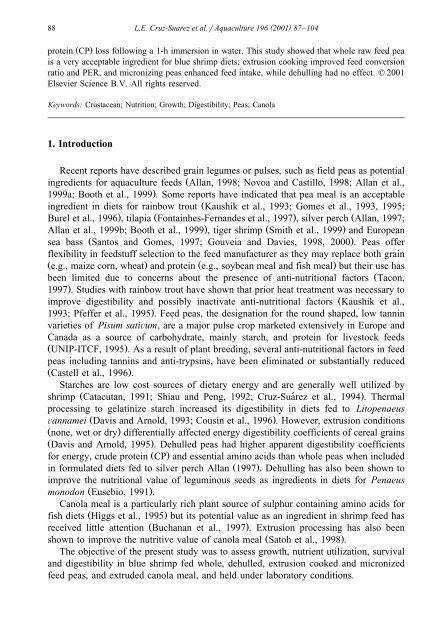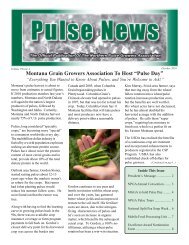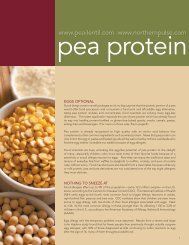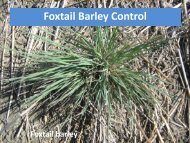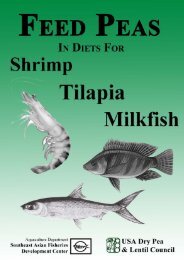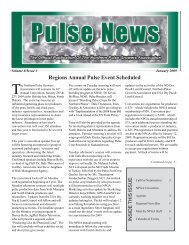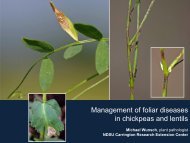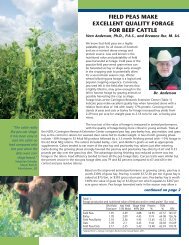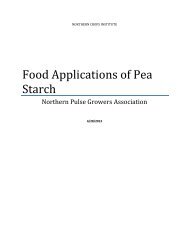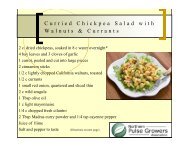Processed feed pea and canola meal for blue shrimp diets
Processed feed pea and canola meal for blue shrimp diets
Processed feed pea and canola meal for blue shrimp diets
You also want an ePaper? Increase the reach of your titles
YUMPU automatically turns print PDFs into web optimized ePapers that Google loves.
88<br />
( )<br />
L.E. Cruz-Suarez et al.rAquaculture 196 2001 87–104<br />
Ž .<br />
protein CP loss following a 1-h immersion in water. This study showed that whole raw <strong>feed</strong> <strong>pea</strong><br />
is a very acceptable ingredient <strong>for</strong> <strong>blue</strong> <strong>shrimp</strong> <strong>diets</strong>; extrusion cooking improved <strong>feed</strong> conversion<br />
ratio <strong>and</strong> PER, <strong>and</strong> micronizing <strong>pea</strong>s enhanced <strong>feed</strong> intake, while dehulling had no effect. q 2001<br />
Elsevier Science B.V. All rights reserved.<br />
Keywords: Crustacean; Nutrition; Growth; Digestibility; Peas; Canola<br />
1. Introduction<br />
Recent reports have described grain legumes or pulses, such as field <strong>pea</strong>s as potential<br />
ingredients <strong>for</strong> aquaculture <strong>feed</strong>s ŽAllan, 1998; Novoa <strong>and</strong> Castillo, 1998; Allan et al.,<br />
1999a; Booth et al., 1999 .. Some reports have indicated that <strong>pea</strong> <strong>meal</strong> is an acceptable<br />
ingredient in <strong>diets</strong> <strong>for</strong> rainbow trout ŽKaushik et al., 1993; Gomes et al., 1993, 1995;<br />
Burel et al., 1996 ., tilapia Ž Fontainhes-Fern<strong>and</strong>es et al., 1997 ., silver perch ŽAllan, 1997;<br />
Allan et al., 1999b; Booth et al., 1999 ., tiger <strong>shrimp</strong> Ž Smith et al., 1999.<br />
<strong>and</strong> Euro<strong>pea</strong>n<br />
sea bass Ž Santos <strong>and</strong> Gomes, 1997; Gouveia <strong>and</strong> Davies, 1998, 2000 .. Peas offer<br />
flexibility in <strong>feed</strong>stuff selection to the <strong>feed</strong> manufacturer as they may replace both grain<br />
Ž e.g., maize corn, wheat. <strong>and</strong> protein Ž e.g., soybean <strong>meal</strong> <strong>and</strong> fish <strong>meal</strong>.<br />
but their use has<br />
been limited due to concerns about the presence of anti-nutritional factors ŽTacon,<br />
1997 .. Studies with rainbow trout have shown that prior heat treatment was necessary to<br />
improve digestibility <strong>and</strong> possibly inactivate anti-nutritional factors ŽKaushik et al.,<br />
1993; Pfeffer et al., 1995 .. Feed <strong>pea</strong>s, the designation <strong>for</strong> the round shaped, low tannin<br />
varieties of Pisum satiÕum, are a major pulse crop marketed extensively in Europe <strong>and</strong><br />
Canada as a source of carbohydrate, mainly starch, <strong>and</strong> protein <strong>for</strong> livestock <strong>feed</strong>s<br />
Ž UNIP-ITCF, 1995 .. As a result of plant breeding, several anti-nutritional factors in <strong>feed</strong><br />
<strong>pea</strong>s including tannins <strong>and</strong> anti-trypsins, have been eliminated or substantially reduced<br />
Ž Castell et al., 1996 ..<br />
Starches are low cost sources of dietary energy <strong>and</strong> are generally well utilized by<br />
<strong>shrimp</strong> Ž Catacutan, 1991; Shiau <strong>and</strong> Peng, 1992; Cruz-Suarez ´ et al., 1994 .. Thermal<br />
processing to gelatinize starch increased its digestibility in <strong>diets</strong> fed to Litopenaeus<br />
Õannamei Ž Davis <strong>and</strong> Arnold, 1993; Cousin et al., 1996 .. However, extrusion conditions<br />
Ž none, wet or dry.<br />
differentially affected energy digestibility coefficients of cereal grains<br />
Ž Davis <strong>and</strong> Arnold, 1995 .. Dehulled <strong>pea</strong>s had higher apparent digestibility coefficients<br />
<strong>for</strong> energy, crude protein Ž CP.<br />
<strong>and</strong> essential amino acids than whole <strong>pea</strong>s when included<br />
in <strong>for</strong>mulated <strong>diets</strong> fed to silver perch Allan Ž 1997 .. Dehulling has also been shown to<br />
improve the nutritional value of leguminous seeds as ingredients in <strong>diets</strong> <strong>for</strong> Penaeus<br />
monodon Ž Eusebio, 1991 ..<br />
Canola <strong>meal</strong> is a particularly rich plant source of sulphur containing amino acids <strong>for</strong><br />
fish <strong>diets</strong> Ž Higgs et al., 1995.<br />
but its potential value as an ingredient in <strong>shrimp</strong> <strong>feed</strong> has<br />
received little attention Ž Buchanan et al., 1997 .. Extrusion processing has also been<br />
shown to improve the nutritive value of <strong>canola</strong> <strong>meal</strong> Ž Satoh et al., 1998 ..<br />
The objective of the present study was to assess growth, nutrient utilization, survival<br />
<strong>and</strong> digestibility in <strong>blue</strong> <strong>shrimp</strong> fed whole, dehulled, extrusion cooked <strong>and</strong> micronized<br />
<strong>feed</strong> <strong>pea</strong>s, <strong>and</strong> extruded <strong>canola</strong> <strong>meal</strong>, <strong>and</strong> held under laboratory conditions.


